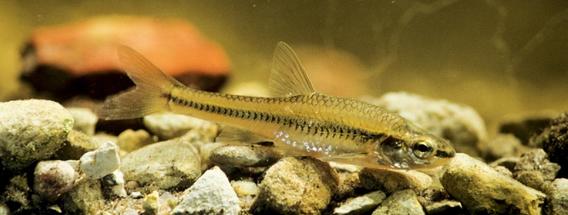
Blacknose and Ozark shiners are experiencing a range of declines. They are a species of concern in several states and climate change restricts species ranges, threatening populations.
Challenge: Little is known about temperature optima, critical temperature limits, or adaptive capacity to tolerate increasing temperature.
Principal Investigator(s):
- Craig Paukert (USGS Missouri Cooperative Fish and Wildlife Research Unit)
Cooperator/Partner(s):
- Jacob Westhoff (Missouri Department of Conservation)
- Doug Novinger (Missouri Department of Conservation)
- Jane Rogosch (University of Missouri)
- James Stoeckel (Auburn University)
Stream fish are in peril from a changing climate, particularly for species with restricted distributions or populations on the southern edge of their range. For these fish, the opportunity to escape warming temperatures is limited by the network of stream channels accessible to them. To deal with temperatures beyond their physical capacity, fishes must move, adapt, or die. However, little is known for many of these species about their preferred temperatures, critical temperature limits, or capacity to adapt to or tolerate increasing temperatures. Researchers will measure the preferred temperatures and tolerance of two stream fish that are vulnerable to climate change: the Ozark Shiner and the Blacknose Shiner. The Ozark Shiner is only found in Missouri and Arkansas and is being considered for listing under the Endangered Species Act, and the Blacknose Shiner may be declining on the edge if its range in Missouri, Iowa, and Illinois.
The research team will use preferred temperature and tolerances determined from lab experiments together with existing data and models of current and future stream temperatures, barriers to fish movement like culverts and dams, and proximity to existing conservation areas to aid conservation planning. This information will help identify where these species are most likely to occur in the future when water temperatures warm, identify barriers to accessing those areas (like dams and stream crossings) that can be prioritized for restoration, and identify nearby state or federal conservation areas that already offer protection. This work will involve state fish and wildlife agency managers to ensure that the work is relevant to their needs, and to facilitate application of the research to ensure these species are here in the future.
Read more from the CASC Project Explorer.
